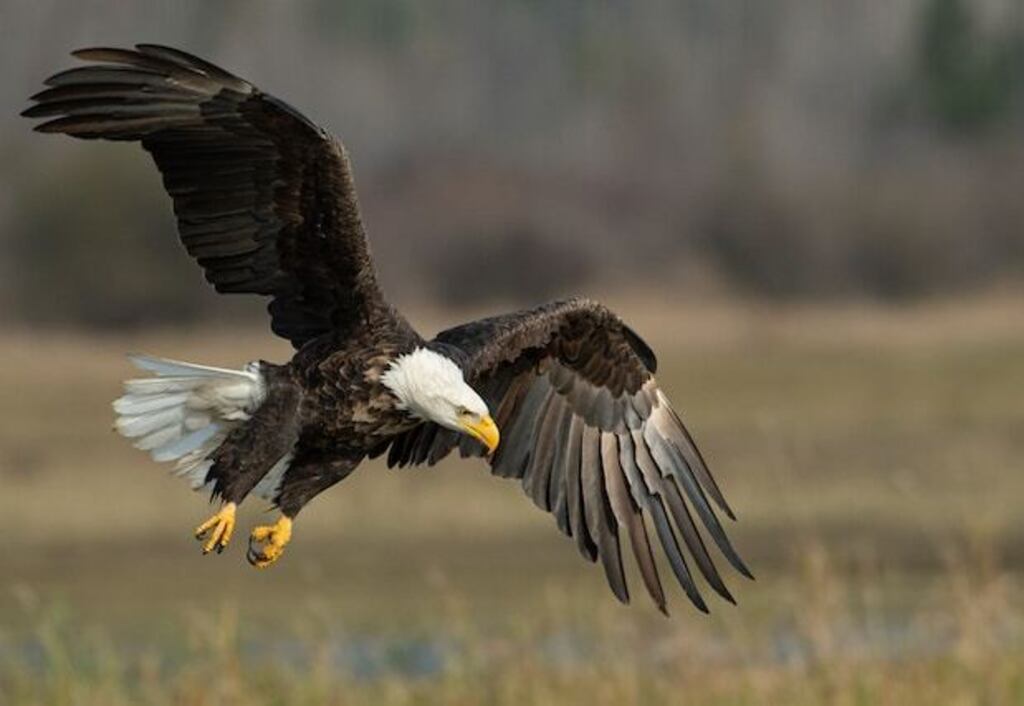Calling All Eagle Enthusiasts: “What Is The Best Time Of Day To See Bald Eagles?” Prepare for a thrilling journey into the world of these majestic birds and the perfect moments to catch them in action.
According to research, the early morning hours steal the show, with eagle activity peaking between sunrise and mid-morning as they showcase their extraordinary hunting skills.
But wait, there’s more! The late afternoon also holds promise as these regal creatures take flight and perch along riverbanks and coastlines.
And that’s not all! Winter months offer prime eagle-spotting opportunities in colder regions, as they migrate to areas with open water.
We’ve got the ultimate guide to maximizing your chances and getting a front-row seat to witness these bald beauties in their natural habitat.
So grab your binoculars, and let’s embark on a memorable eagle quest!
Table of Contents
- 1 Key Takeaways
- 2 What Is The Best Time Of Day To See Bald Eagles
- 3 Early Morning Hours
- 4 Late Afternoon
- 5 Winter Months
- 6 Coastal Areas
- 7 Riverbanks
- 8 Lakes and Reservoirs
- 9 Nature Reserves and Wildlife Refuges
- 10 Spring and Fall Migration Periods
- 11 Quiet and Undisturbed Locations
- 12 Patience and Persistence
- 13 Frequently Asked Questions
- 13.1 How long does the spring and fall migration period typically last for bald eagles?
- 13.2 Are there any specific lakes or reservoirs known for having a higher concentration of bald eagles?
- 13.3 Can bald eagles be spotted in nature reserves and wildlife refuges year-round or only during specific seasons?
- 13.4 Which coastal areas in the article are mentioned as the best for observing bald eagles?
- 13.5 How important is it to remain quiet and undisturbed while observing bald eagles?
- 14 Conclusion
- 15 Author
Key Takeaways
- The best time to observe bald eagles is early morning and late afternoon.
- Eagles are most active during sunrise and mid-morning, as well as in the late afternoon.
- Winter months offer excellent opportunities to spot bald eagles, as they migrate to areas with open water in colder climates.
- Visit nature reserves, wildlife refuges, and quiet locations near water bodies to maximize chances of seeing eagles.
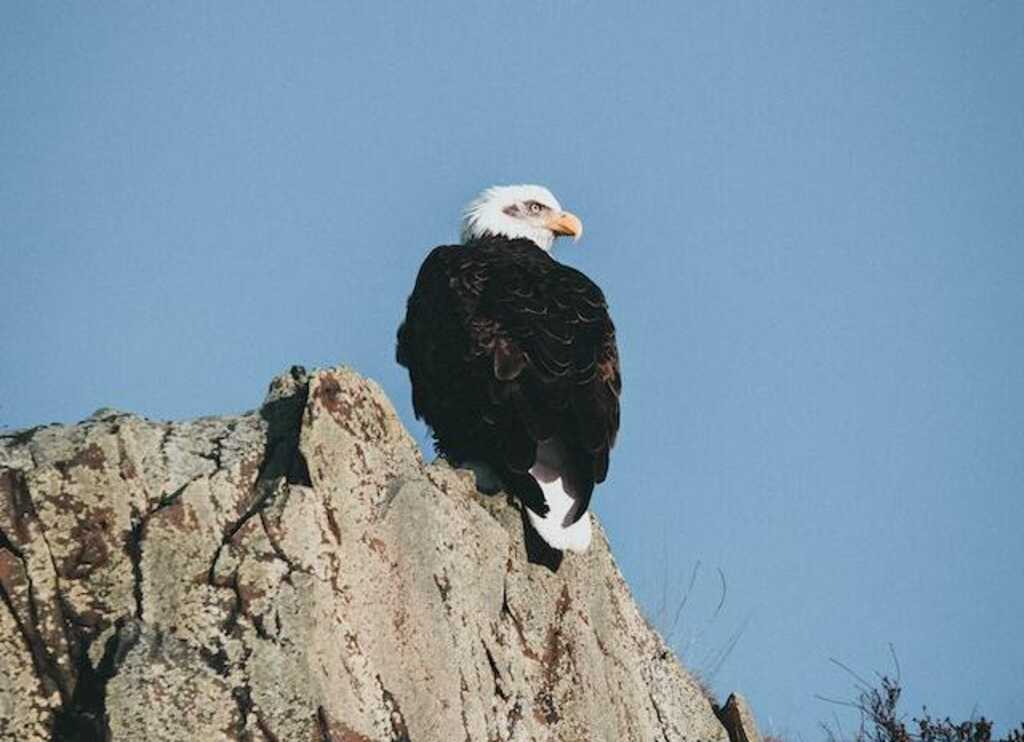
What Is The Best Time Of Day To See Bald Eagles
The best time to see bald eagles is during the early morning hours, from sunrise to mid-morning. They are most active, hunting for prey, during this time.
Late afternoon also offers good opportunities to spot eagles soaring or perched along riverbanks and coastlines. Winter months in colder regions are favorable, as eagles migrate to areas with open water.
Early Morning Hours
During the early morning hours, when the sun is just beginning to rise, is considered the optimal time to observe bald eagles due to their increased activity levels and heightened visibility in the soft, diffuse light.
Early morning birdwatching provides a unique opportunity to witness the eagles’ hunting behavior as they search for prey in the calm waters.
The golden hues of the rising sun create the best photography lighting, enhancing the majestic appearance of these iconic birds.
Observing bald eagles during this time allows for a clearer view of their intricate feather patterns and impressive wingspan, captivating any nature enthusiast.
Furthermore, the stillness of the morning air allows their distinctive calls to resonate, adding to the overall experience.
Transitioning into the subsequent section about late afternoon, the diminishing daylight brings about a different dynamic in eagle behavior.
Late Afternoon
In the late afternoon, before sunset, eagles may exhibit increased activity levels.
This time of day often offers beautiful lighting, known as the golden hour, which can enhance the quality of photographs taken of these majestic birds.
Additionally, the late afternoon may provide opportunities to witness social interactions among eagles, as they gather and communicate with one another.
Eagles may be more active in the late afternoon before sunset
Towards the late afternoon, as the sun begins its descent, bald eagles display heightened activity levels, captivating observers with their majestic presence.
This period, commonly referred to as the golden hour in photography, offers a unique opportunity to witness the social behavior of these magnificent birds.
During this time, eagles may engage in various activities such as hunting, feeding, and interacting with other eagles. To further understand their behavior, a table is presented below:
| Activity | Description |
|---|---|
| Hunting | Eagles scan the area for potential prey, such as fish or small mammals. |
| Feeding | Once a suitable target is spotted, eagles swoop down to catch their prey. |
| Interacting | Eagles may engage in aerial displays or vocalizations to communicate with other individuals. |
The late afternoon also provides beautiful golden hour lighting for capturing stunning photos of bald eagles in their natural habitat. This enchanting lighting enhances the details of their plumage and creates a warm, glowing ambiance.
Beautiful golden hour lighting for capturing stunning photos
The mesmerizing glow of the late afternoon sun casts a golden hue on the landscape, illuminating the majestic plumage of the bald eagles and creating a captivating ambiance for photographers to capture stunning images.
During this golden hour, the soft, warm light enhances the colors and textures of the eagles, resulting in breathtaking photographs. To fully engage with this photography opportunity, consider the following subtopics:
- Lighting: The golden hour lighting during sunset provides a soft, warm glow that adds depth and dimension to the images, making the eagles stand out against the backdrop.
- Silhouettes: Experiment with capturing silhouettes of the eagles against the vibrant hues of the sunset, creating dramatic and artistic photographs.
- Reflections: Utilize the golden hour lighting to capture the reflections of the eagles in calm water bodies, adding a sense of tranquility to the photographs.
Transitioning into the next section, witnessing social interactions among eagles during this enchanting time can provide additional insights into their behavior and dynamics.
Social interactions among eagles can be observed during the magical golden hour, providing valuable insights into their behavior and dynamics.
This period, characterized by beautiful golden lighting, offers a unique opportunity to witness courtship displays and territorial disputes among bald eagles.
Courtship displays involve elaborate aerial acrobatics and vocalizations, as males and females engage in intricate rituals to attract a mate.
Additionally, territorial disputes can be observed as eagles fiercely defend their nesting sites and hunting grounds from intruders.
These social interactions among eagles not only showcase their strength and agility but also reveal their complex social structure and hierarchical relationships.
Understanding these behaviors is crucial for studying eagle populations and monitoring their conservation status.
Transitioning to the subsequent section about the winter months, this time of year holds its own significance for observing bald eagles in their natural habitats.

Winter Months
Winter months offer a captivating opportunity to witness the majestic flight of bald eagles.
These months bring about serene winter landscapes, characterized by snow-covered trees and frozen lakes, providing a picturesque backdrop for observing these magnificent birds.
During this time, bald eagles exhibit unique behaviors that add to the allure of their presence.
They engage in intricate aerial displays, soaring gracefully through the crisp winter air, showcasing their agility and strength.
Additionally, they can be seen perched on tree branches, scanning the surroundings for potential prey or potential mates.
The tranquil atmosphere of winter further enhances the experience, allowing for a more peaceful and immersive observation of these majestic creatures.
As we transition to exploring coastal areas, the winter months continue to offer an ideal setting for encountering bald eagles in their natural habitat.
Coastal Areas
Coastal areas provide a favorable environment for observing the magnificent flight and perching behaviors of bald eagles.
These areas offer potential nesting sites, which are crucial for the breeding success of these majestic birds.
Coastal regions attract a diverse range of coastal bird species, such as gulls, terns, and waterfowl, which provide a reliable source of food for the eagles.
Additionally, the proximity to bodies of water, such as oceans, rivers, and estuaries, offers ample opportunities for the bald eagles to hunt for fish, their primary food source.
The abundance of perching sites, including tall trees and rocky cliffs, allows the eagles to survey their surroundings and spot potential prey.
Furthermore, the coastal areas’ unique geographical features, such as rocky outcrops and sea stacks, provide stunning backdrops for observing the bald eagles in their natural habitat.
Transitioning to the subsequent section about ‘riverbanks,’ these areas also offer favorable conditions for eagle sightings.
Riverbanks
Riverbanks provide a unique opportunity for observing the impressive hunting and foraging behaviors of bald eagles, as these areas offer a diverse range of prey species and ample perching sites for the eagles to survey their surroundings.
| Tips | Description |
|---|---|
| Choose a vantage point | Find a spot with a clear view of the riverbank where eagles are likely to perch or hunt. |
| Bring binoculars | Binoculars allow you to observe eagles from a distance without disturbing them. |
| Be patient | It may take some time for eagles to appear, so be prepared to wait quietly and attentively. |
These tips can enhance your birdwatching experience as you observe the fascinating riverbank activities of bald eagles. In the subsequent section about ‘lakes and reservoirs,’ we will explore another habitat where bald eagles can be spotted.
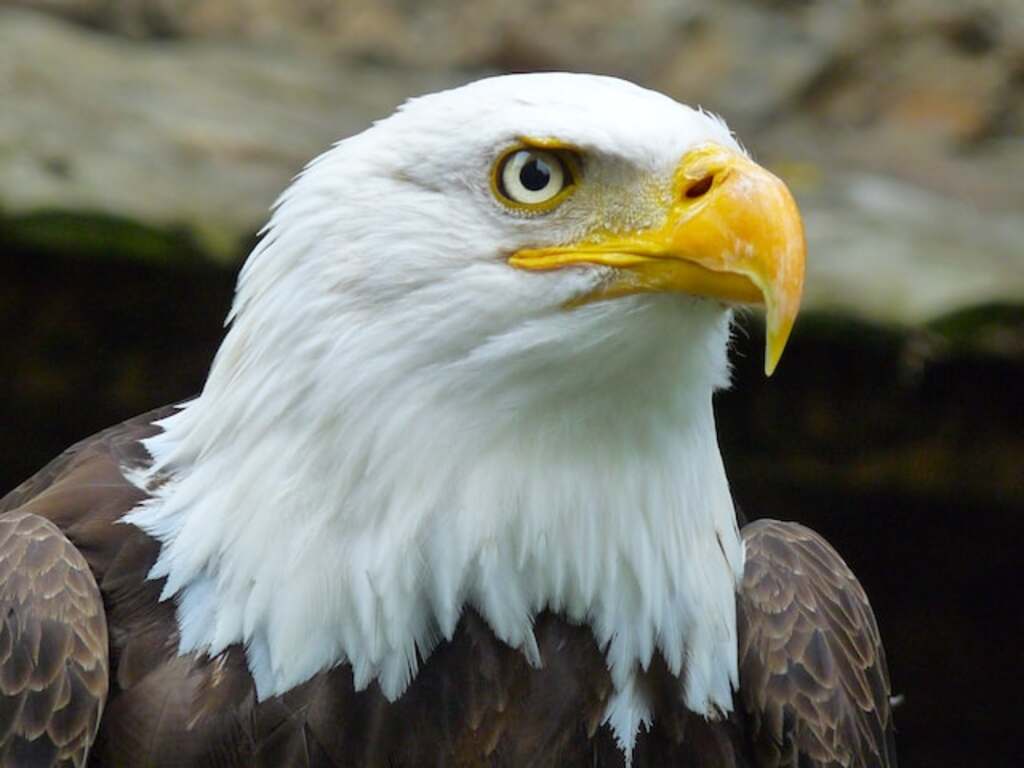
Lakes and Reservoirs
Lakes and reservoirs play a crucial role in providing food sources and nesting sites for bald eagles. These water bodies are abundant with fish and other aquatic species, which serve as the main prey for eagles.
As a result, eagles can often be seen soaring above lakes and reservoirs, scanning the waters below for potential meals.
Moreover, these bodies of water create serene and picturesque environments that are ideal for eagle watching, allowing observers to marvel at the beauty of these majestic birds in their natural habitats.
Lakes and reservoirs provide food sources and nesting sites for eagles
Nestled within the watery embrace of these vast bodies lie an abundant array of sustenance and shelter for the majestic bald eagles. Lakes and reservoirs serve as critical habitats for these birds, providing them with ample food sources and nesting sites.
The eagle’s hunting techniques are well adapted to their aquatic surroundings, as they rely on their keen eyesight and powerful talons to catch fish and other prey.
However, human activities can have a significant impact on these habitats.
Pollution from industrial and agricultural runoff, as well as disturbance caused by recreational activities, can disrupt the delicate balance of these ecosystems and negatively affect the eagle population.
Despite these challenges, eagles can be seen soaring above these water bodies in search of prey, showcasing their remarkable adaptability and resilience.
Eagles can be seen soaring above these water bodies in search of prey
Lakes and reservoirs serve as crucial habitats for bald eagles, providing them with ample food sources and nesting sites.
These water bodies are not only a source of sustenance but also offer a vantage point for the eagles to spot potential prey.
Eagles have developed remarkable hunting techniques, and soaring above the water bodies allows them to scan the surface for fish and other small animals.
This hunting strategy, known as aerial fishing, involves the eagle rapidly descending from its soaring flight to snatch its prey from the water’s surface.
In addition to aerial fishing, eagles also employ other hunting methods, such as perching and scavenging.
These varied hunting techniques enable eagles to adapt to different environments and maximize their chances of finding food.
Transitioning into the subsequent section, these serene and picturesque environments provide the perfect backdrop for eagle watching, offering a peaceful and captivating experience.
Serene and picturesque environments for eagle watching
Surrounded by breathtaking natural beauty, these tranquil and idyllic settings provide an ideal backdrop for observing the majestic presence of eagles in their natural habitat.
The serene landscapes, with their pristine bodies of water and lush vegetation, create a sense of peace and tranquility that is perfect for eagle watching.
These picturesque environments not only offer a sense of calm but also provide ideal photography conditions, allowing enthusiasts to capture stunning images of these magnificent birds in flight.
The stillness of the water bodies reflects the eagles’ graceful movements, while the vibrant colors of the surrounding flora enhance the overall aesthetic appeal.
For those seeking a moment of respite and a chance to connect with nature, these serene settings offer an unparalleled experience.
Transitioning to the subsequent section about ‘nature reserves and wildlife refuges,’ one can explore further opportunities to witness the wonders of eagle conservation and preservation.
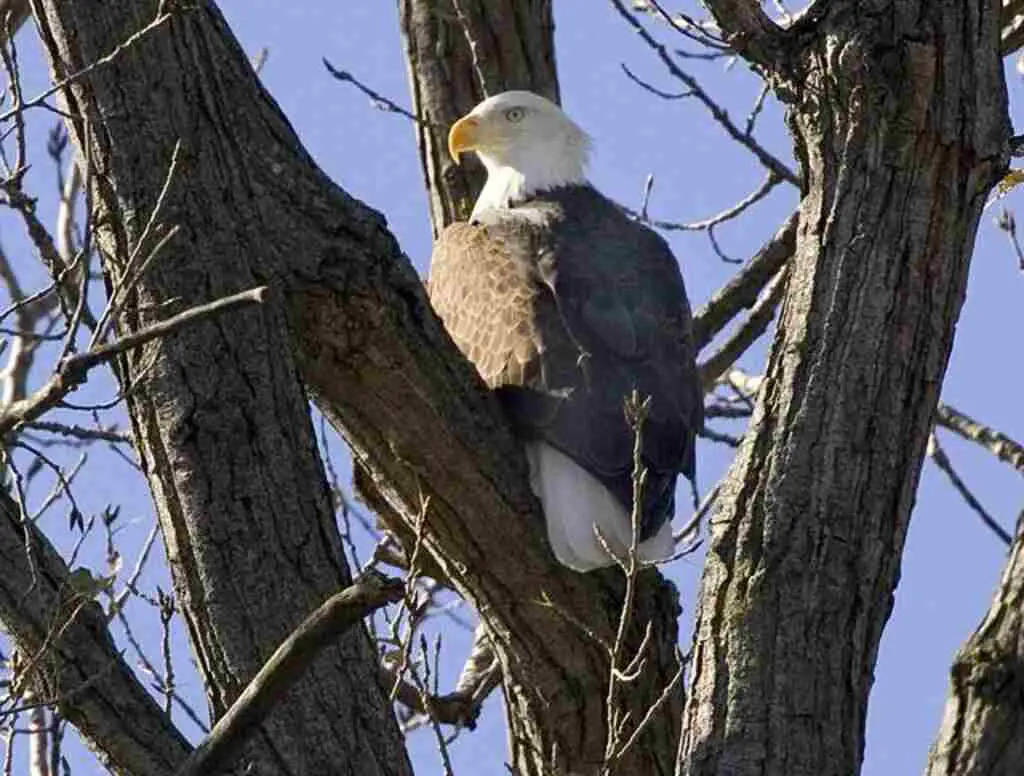
Nature Reserves and Wildlife Refuges
Protected by the boundaries of designated areas, nature reserves and wildlife refuges provide an environment where bald eagles can thrive undisturbed, granting visitors the opportunity to witness the majestic birds in their natural habitat.
- Nature photography: These protected areas offer ideal settings for capturing breathtaking images of bald eagles in flight or perched on tree branches, giving photographers the chance to showcase the grace and beauty of these birds.
- Birdwatching techniques: Visitors can employ various birdwatching techniques, such as using binoculars or spotting scopes, to observe the bald eagles’ behavior and study their distinctive features up close.
- Educational programs: Many nature reserves and wildlife refuges organize educational programs that provide valuable insights into the behavior, habitat, and conservation efforts surrounding bald eagles.
- Guided tours: Experienced guides lead visitors through the reserves, sharing their knowledge about bald eagles and pointing out interesting facts about their habitat and ecology.
Transitioning into the subsequent section about ‘spring and fall migration periods,’ these designated areas also serve as crucial stopover points for bald eagles during their seasonal journeys.
Spring and Fall Migration Periods
During the spring and fall migration periods, nature reserves and wildlife refuges serve as important waypoints for the seasonal journeys of bald eagles.
These majestic birds undertake long-distance migrations, with some individuals traveling thousands of miles between their breeding and wintering grounds.
In the spring, bald eagles migrate northwards from their wintering areas to breed in northern regions, while in the fall, they make the journey back to their wintering grounds in the south.
Nature reserves and wildlife refuges provide crucial stopover points for these migratory eagles, offering abundant food resources and suitable habitats for resting and refueling.
These protected areas play a vital role in supporting the survival and successful migration of bald eagles.
Next, we will explore the significance of quiet and undisturbed locations for observing these magnificent birds in their natural habitat.
Quiet and Undisturbed Locations
Nestled amidst the tranquil embrace of nature, the observance of serene and secluded locations offers a captivating glimpse into the ethereal grace of bald eagles in their undisturbed habitat.
To optimize the chances of spotting these majestic creatures, it is essential to visit these locations during the best time of day.
The early morning hours, just after sunrise, and the late afternoon hours, just before sunset, are ideal for eagle sightings.
During these periods, the eagles are most active, soaring through the sky with grace and hunting for prey. To enhance the experience, here are four key factors to consider:
- Choose a location near a water body, such as a river or lake, as eagles often hunt for fish.
- Look for tall trees or cliffs, as eagles prefer perching at higher vantage points.
- Opt for locations with minimal human activity, as eagles are easily disturbed by noise and presence.
- Bring binoculars or a telephoto lens to observe the eagles from a distance without disturbing them.
By adhering to these guidelines, one can immerse themselves in the awe-inspiring world of bald eagles in their undisturbed natural habitat.
Transitioning to the next section, patience and persistence play a crucial role in capturing the perfect moment with these magnificent birds.
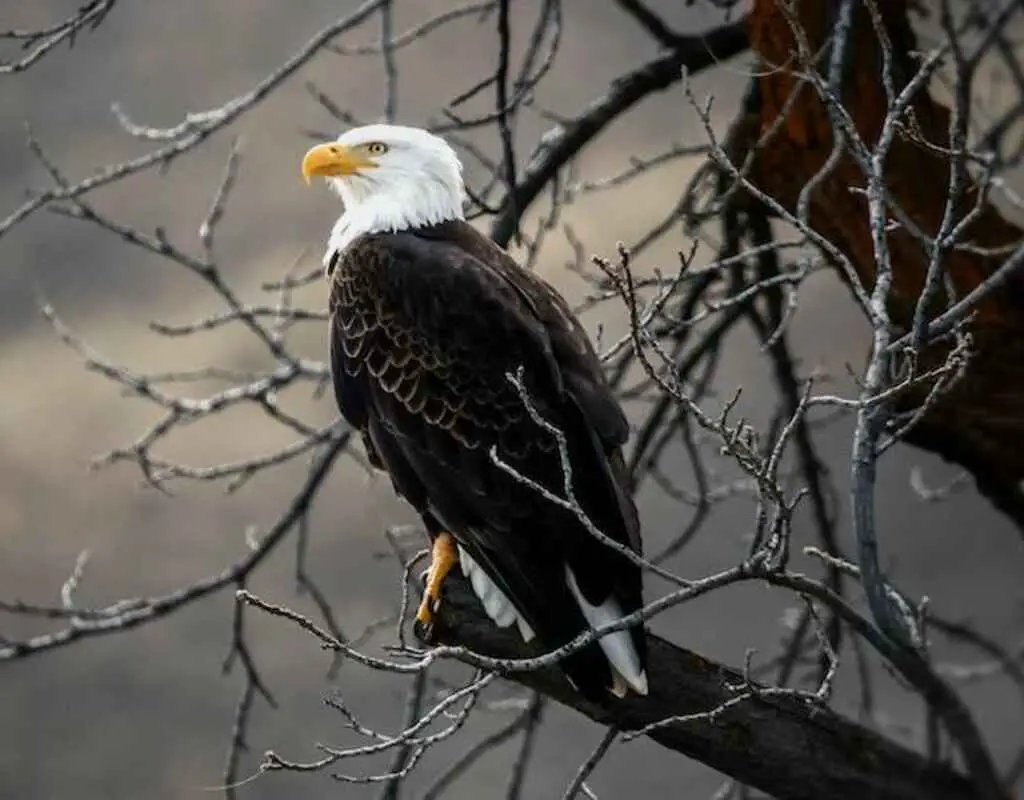
Patience and Persistence
Eagle sightings are not guaranteed, but patience is key when it comes to observing these majestic birds.
It is important to spend ample time in eagle habitats, carefully observing their behavior and movements.
To increase the chances of spotting an eagle, one must stay alert and continuously scan the sky and surrounding areas for any signs of eagle activity.
Eagle sightings are not guaranteed, but patience is key
| Behavior and Habit | Insights |
|---|---|
| Impressive Wingspan | A key feature of bald eagles, their wingspan can range from 6 to 7.5 feet, making them easily recognizable in flight. |
| Hunting Behavior | Observing during the early morning hours increases chances of witnessing eagles actively hunting for prey. |
| Habitat Preferences | Visiting nature reserves and wildlife refuges offers a higher likelihood of encountering eagles in their undisturbed habitat. |
| Winter Migration | In colder climates, eagles migrate to areas with open water, such as coastal regions, to find an abundance of food. |
| Patience and Dedication | Spending ample time observing eagle habitats and behavior is crucial to gaining valuable insights into their daily routines and preferences. |
| Unpredictable Sightings | Eagle sightings are not guaranteed, making exercising patience and perseverance essential for encountering these majestic creatures. |
Spend ample time observing eagle habitats and behavior
To gain a deeper understanding of the habitats and behavior of eagles, it is imperative to invest significant amounts of time in observing and studying these majestic creatures.
By spending ample time in their habitats, one can witness the intricate feeding habits of eagles.
These birds of prey are known for their keen eyesight and swift hunting skills, often targeting fish as their primary food source.
Observing their feeding behavior can provide valuable insights into their ecological role and their impact on local ecosystems.
Additionally, studying eagle nesting behavior can reveal important information about their reproductive patterns and the factors that contribute to successful breeding.
By patiently observing these behaviors, researchers and enthusiasts can unravel the mysteries surrounding these magnificent birds.
Thus, spending time observing eagle habitats and behavior is crucial for gaining a comprehensive understanding of these creatures and their ecological significance.
Transitioning to the next section, staying alert and scanning the sky and surrounding areas for eagle activity is essential for maximizing sightings and experiences with these remarkable birds.
Stay alert and keep scanning the sky and surrounding areas for eagle activity
Remaining vigilant and continuously scanning the sky and surrounding areas is crucial for maximizing the chances of observing eagle activity.
Bald eagles are known for their impressive aerial displays and soaring flights, making them a captivating sight for wildlife enthusiasts.
To increase the likelihood of spotting these majestic birds, it is essential to stay alert and keep an eye out for any signs of eagle activity.
This includes scanning the sky for soaring eagles, as well as observing their behavior in the surrounding areas.
Additionally, the golden hour of photography, which occurs during the early morning or late afternoon, can offer optimal lighting conditions for capturing stunning images of bald eagles.
Moreover, observing social interactions among eagles, such as their mating rituals or territorial disputes, can provide valuable insights into their behavior and hierarchy within their habitat.
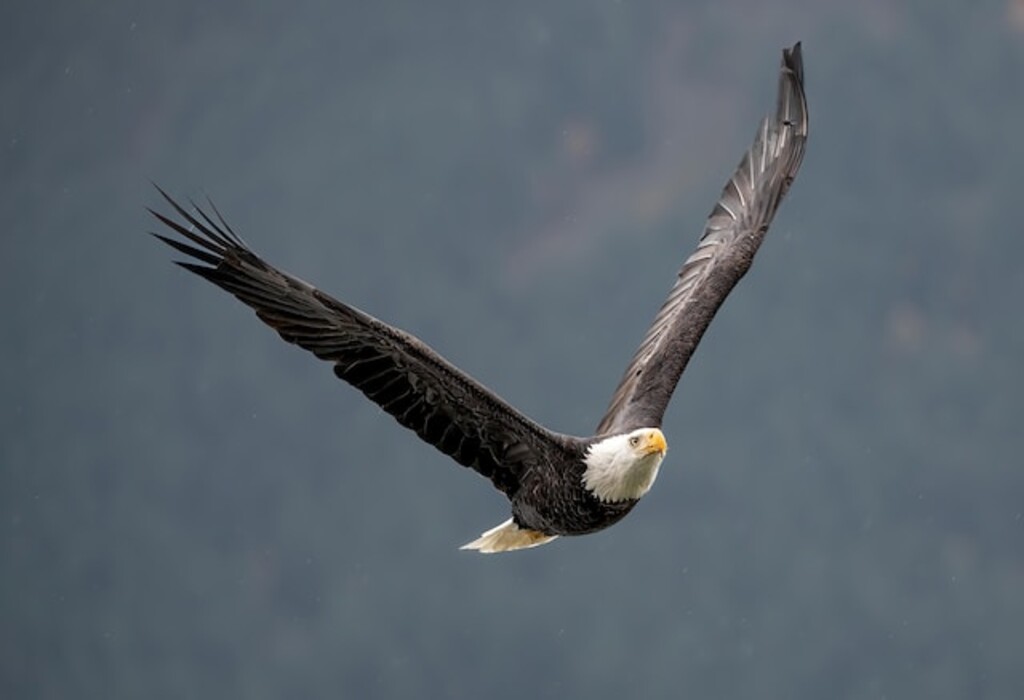
Frequently Asked Questions
How long does the spring and fall migration period typically last for bald eagles?
The spring and fall migration periods for bald eagles typically last for several months. Migration patterns are influenced by factors such as food availability, weather conditions, and breeding behaviors.
Are there any specific lakes or reservoirs known for having a higher concentration of bald eagles?
Certain lakes and reservoirs are known for having a higher concentration of bald eagles. The best time to see them at these specific locations is during their migration periods, which typically last for several weeks in the spring and fall.
Can bald eagles be spotted in nature reserves and wildlife refuges year-round or only during specific seasons?
Bald eagles can be spotted in nature reserves and wildlife refuges year-round. The presence of bald eagle populations in these areas is influenced by their nesting habits, which determine their preferred habitats and availability of food sources.
Which coastal areas in the article are mentioned as the best for observing bald eagles?
The article provides detailed information on the coastal areas that are considered the best for observing bald eagles. It highlights the significance of these locations for birdwatching enthusiasts and provides insights on where to observe bald eagles.
How important is it to remain quiet and undisturbed while observing bald eagles?
Remaining undisturbed while observing bald eagles is crucial as it has several benefits and impacts on their behavior. It allows for better observation of natural behaviors and minimizes stress, ensuring accurate data collection and a positive experience for both eagles and observers.
Conclusion
The best time of day to observe bald eagles is during the early morning hours or late afternoon, as they are most active during these times.
The winter months are particularly ideal, as eagles tend to gather in larger numbers near open water sources for feeding.
Coastal areas, riverbanks, and nature reserves are prime locations for spotting these majestic birds.
Spring and fall migration periods also offer opportunities to see bald eagles.
To increase chances of sightings, one should visit quiet and undisturbed locations, and exercise patience and persistence.
When can you witness the awe-inspiring sight of bald eagles soaring through the skies?

